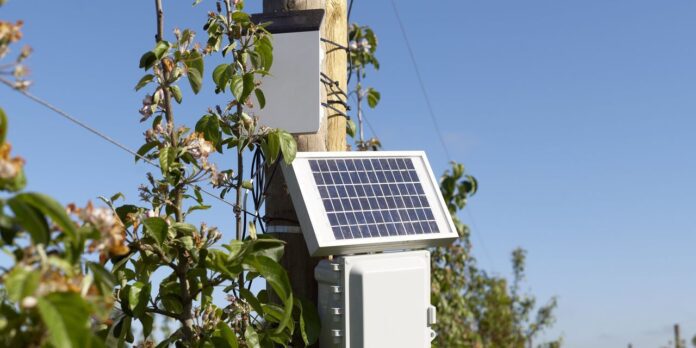[ad_1]
It was one of 5G’s big selling points: millions of always-connected internet-of-things devices exchanging data wirelessly at lightning speed, revolutionizing the portability of everything from augmented-reality goggles to surveillance cameras.
Several years into the 5G rollout, the internet-of-things boom largely hasn’t happened. There were about 4.4 million 5G-connected internet-of-things devices in the U.S. in 2021, according to analysis firm International Data Corp.—a sizable number but a drop in the bucket compared with the nearly 100 million smartphones capable of 5G.
The slow uptake for nonphone gadgets had been expected, to an extent, during the 5G rollout, analysts and industry executives say. Device makers and cellular network operators tend to focus first on upgrading phones and cell towers when new generations of equipment come out. Only once that has been proven out do they turn to other growth segments like IoT.
The sluggishness this time, however, also illustrates how some users of IoT devices don’t yet see the financial logic in upgrading to 5G, says
Sandra Wendelken,
an IDC analyst. Healthcare workers who use IoT devices to care for patients or companies that use devices to track employees’ work habits, for example, are largely comfortable with the connectivity of their existing gear, she says. Many don’t yet see that the features offered by 5G—notably faster data-transmission speeds—are worth the price of an upgrade.
“The majority aren’t using 5G technology because the return on investment isn’t yet there,” Ms. Wendelken says.
Long life
Another factor weighing on 5G is that some of the most powerful new internet-of-things applications demand long battery life that 5G devices can’t deliver.
Farmers have started to deploy wireless soil-moisture sensors to pinpoint irrigation, for example, but those devices are cheaper and easier to manage when they run on long-lasting batteries and rely on older connectivity technology. The same constraint applies to many smart-city devices, like parking meters that run on solar cells, and to retail-industry applications like digital price tags.
In some of those applications, where wired connections aren’t possible, a 5G antenna could help by transmitting data from small, battery-powered sensors to big data centers for further processing. But there’s little role for 5G technology to be directly embedded into many internet-of-things devices, says
Mohan Maheswaran,
chief executive officer of
Semtech Corp.
, which designs chips for low-power devices.
“5G is really geared toward very high-bandwidth connectivity, so for streaming video and high-bandwidth data,” Mr. Maheswaran says. “It doesn’t ordinarily lend itself to a parking sensor or a light sensor.”
a chip designer that also specializes in circuits for low-power IoT devices, also hasn’t seen a swarm of 5G devices on the market, CEO
Matt Johnson
says.
The technology holds promise, he says, but the battery-consumption issues combined with the high cost could be a lasting constraint on its growth. For the customers of these devices, 5G connectivity costs many times as much as relying on Bluetooth, Wi-Fi and other means of exchanging data wirelessly, he says.
“Think about an order-of-magnitude different cost and an order-of-magnitude different battery life, and what you end up with is that some applications are perfect for cellular and 5G, and some applications will never be candidates,” he says.
Just beginning
Still, some of 5G’s most ardent backers say the internet-of-things wave is only beginning.
Augmented-reality and virtual-reality goggles are becoming more popular, and increasingly being untethered from clunky computers. Industries are beginning to use 5G to control machinery in factories, minimizing downtime when they want to move that machinery around. Companies are expected to eventually use more 5G, too, equipping employees with more connected devices to help them work and track how they’re doing.Those applications have taken time to develop.
SHARE YOUR THOUGHTS
What role do 5G-connected devices play in your technological life? Join the conversation below.
Durga Malladi,
a senior vice president at chip maker
Qualcomm Inc.,
one of the main backers of the shift to 5G, says the growth of IoT devices was part of the second phase of the broader 5G story—a stage that’s still in relative infancy. The technical standards that define what 5G is are being updated over time to cater to nonphone gadgets, he says, which 5G’s backers hope will jump-start the market.
As part of that advance, he says, “you’ll see the expansion of 5G to all kinds of new use cases and in turn creating new kinds of devices that didn’t exist in the 4G era.”
Ms. Wendelken of IDC says issues like the Covid-19 pandemic and supply-chain disruptions caused by it have been another unanticipated stumbling block for the internet-of-things market, constraining the growth in 5G-enabled devices. Despite those issues, IDC is still forecasting that there will be 187 million 5G IoT connections in the U.S. by 2026—an exponential growth trajectory that supports the bullish case for the industry.
“Growth has been slower than some in the industry had hoped, but many factors related to the standard, the pandemic, and supply-chain and economic issues played a part,” Ms. Wendelken says. “There have been fits and starts to each wireless-technology generation, and 5G is no different.”
Mr. Fitch is a reporter for The Wall Street Journal in San Francisco. Email him at [email protected].
Copyright ©2022 Dow Jones & Company, Inc. All Rights Reserved. 87990cbe856818d5eddac44c7b1cdeb8
[ad_2]
Source link

